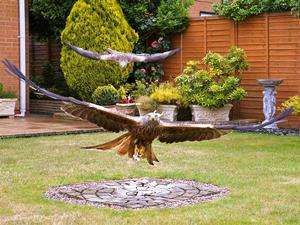Red kites 'commute' into suburbs to be fed

A rare bird of prey, once almost extinct in Britain and Ireland, has made a spectacular return to the skies above UK towns thanks to people feeding them, new research has found.
Almost one in 20 households around Reading, Berkshire - the equivalent of more than 4,300 households - regularly feed red kites, causing the birds to 'commute' into the town from the surrounding countryside, scientists from the University of Reading have discovered.
With a 1.75m wingspan, red kites were once a common and impressive sight over medieval towns, where they were welcomed as they helped keep the streets free of rotting carrion (the carcasses of dead animals). But following centuries of persecution, only one or two pairs survived in Wales by the 1930s.
Following a hugely successful reintroduction programme which started in the Chiltern Hills in 1989, red kites have returned as a widespread British bird of prey. Now research at the University of Reading, led by Dr Mel Orros and Professor Mark Fellowes and published in the journal Ibis, has uncovered why they have returned to our modern towns.
While almost half of UK households regularly feed wild birds, most of us stick to filling up peanuts or seed in a feeder for our garden blue tits or robins. However, the researchers found that many people in Reading are aiming for much bigger visitors. Here, many people regularly put out pieces of meat, particularly chicken, in order to attract red kites into their gardens, they found.
Daily 'commuters'
Professor Fellowes, the University of Reading ecologist who supervised the study, said: "There are very few nesting or natural feeding sites in suburban areas, but we know that hundreds of red kites visit Reading every day.
"People had assumed waste food and road kill attracted them, but very little of this is actually available as our modern towns are remarkably clean. What we found was that people in Reading are providing enough food to provide the daily food needs for hundreds of red kites. The birds seem to be 'commuting' into the town each day from the surrounding countryside for a meal."
Brenda King, a receptionist from Earley, Reading, said she occasionally put raw or leftover meat out for the kites. She said: "They are beautiful birds and to be able to see them up close is just marvellous.
"We don't feed them every day or give them too much, because they are wild birds. We never had them here until a few years ago. Now they will come in six at a time."
Feeding red kites is controversial. Some conservation groups have asked people not to feed the kites, arguing that the birds can find enough food in the wild without having to depend on hand-outs from humans. There have also been some reports of birds swooping into gardens to steal food from picnics or barbecues. But this latest research suggests that in Reading, the abundance of birds seen during the daytime - up to 300 each day - are primarily drawn in by the food left out deliberately by people.
'Lifeboat for species'
Professor Fellowes said it was possible that feeding had helped to boost the birds' breeding success and increased their chances of surviving periods of cold or wet winter weather, which made finding food in the wild difficult, but added further research would be needed to confirm this.
"Red kites are a beautiful and charismatic species, and it should be a cause for great celebration that their reintroduction has gone so well," he said.
"The success of the species in the UK means we may now act as a lifeboat for red kites, as numbers in their European strongholds are in decline."
There are now thought to be around 2,700 breeding pairs across the UK. While people have become accustomed to feeding them in the area near the Chilterns where they were first introduced, Professor Fellowes thinks people elsewhere may now follow suit as the species spreads out across the country.
"Providing supplementary food is a wonderful way to help garden birds, while allowing us to get close to nature," he said. "But who would have thought that our fascination with feeding birds would result in such a spectacular species becoming a common suburban sight?"
More information: "Widespread supplementary feeding in domestic gardens explains the return of reintroduced Red Kites Milvus milvus to an urban area." Ibis, 157: 230–238. doi: 10.1111/ibi.12237
Provided by University of Reading


















